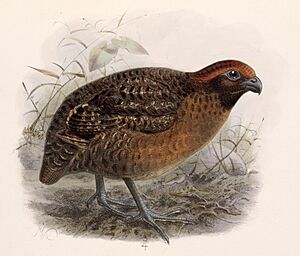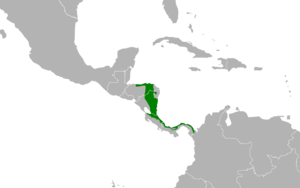Black-eared wood quail facts for kids
Quick facts for kids Black-eared wood quail |
|
|---|---|
 |
|
| Conservation status | |
| Scientific classification | |
| Genus: |
Odontophorus (bird)
|
| Species: |
melanotis
|
 |
|
The black-eared wood quail (Odontophorus melanotis) is a cool bird found in the forests of Central America. It's part of a group called Galliformes, which includes chickens and turkeys. For a long time, people thought this quail was related to "Old World quail" (from places like Europe and Asia). But new science, using DNA, showed that it's actually part of the "New World quail" family, called Odontophoridae. This means it's more closely related to quails found in the Americas.
These birds are a bit of a mystery because there isn't a lot of information about them. We know they live in tropical and subtropical forests. They are usually found alone, in pairs, or in small groups. Black-eared wood quails eat insects and fruit. They are also thought to stay with one partner for life, which is called being monogamous.
Contents
What Does a Black-eared Wood Quail Look Like?
The black-eared wood quail is a chicken-like bird that lives in Central America. Its body is mostly dark brown or black, with a reddish-brown chest. The most special parts of this bird are its solid reddish-brown crown (the top of its head) and crest (a tuft of feathers on its head). It also has a black face and throat.
This quail has a black beak and blue-black legs. Around its eye, there's a bare ring of skin that's purple. Female black-eared wood quails look a lot like the males. However, their eye ring is blue-black instead of purple, and the sides of their head are a bit darker. Their reddish-brown colors are also not as bright.
The black-eared wood quail looks very similar to the Rufous-fronted wood quail. But you can tell them apart because the Rufous-fronted wood quail has a clear white band on its throat, which the black-eared wood quail does not have.
Where Do Black-eared Wood Quails Fit in Nature?
Black-eared wood quails belong to a group called Odontophorus. This group is the largest within the New World quail family. It has the most species and covers the biggest area. Birds in the Odontophorus group are usually large and live in forests.
Scientists have often thought that the black-eared wood quail was just a type of Rufous-fronted wood quail. But there's no clear proof that they mix and have babies together. So, they are now considered two different species. The black-eared wood quail's scientific name is Odontophorus melanotis, and the Rufous-fronted wood quail's name is Odontophorus erythrops.
There are two known types, or subspecies, of black-eared wood quail:
- Odontophorus melanotis verecundus (discovered in 1929). This type lives in the Caribbean side of Honduras.
- Odontophorus melanotis melanotis (discovered in 1865). This type is found in southeast Honduras, Nicaragua, and along the Caribbean coast of Costa Rica and Panama.
Where Do Black-eared Wood Quails Live?
Most Odontophorus species, including the black-eared wood quail, love living in forests. They are usually found in tropical and lower subtropical forests. These birds spend their time on the ground. You can often find them in very old forests or in thick areas where new trees have grown after old ones were cut down.
The black-eared wood quail lives across the Caribbean side of Central America. This includes Honduras, Nicaragua, Costa Rica, and eastern Panama. They might also live in the northwest part of Colombia.
How Do Black-eared Wood Quails Behave?
Black-eared wood quails are believed to stay in one place and not migrate. You can find them alone, in pairs, or in small groups of up to 10 or 12 birds. These groups are called coveys.
What Sounds Do They Make?
Many New World wood quails sing duets, which means two birds sing together. Black-eared wood quails make soft, cooing or peeping sounds when they talk to each other in their covey. They also have a special call to attract others. This is a loud, ringing duet that can be sung by just one bird and heard from far away. People describe the sound as "kooLAWlik kooLAWlik kooLAWK kooLAWK" or "LAWcooKLAWcoo."
What Do They Eat?
We don't know much about what black-eared wood quails eat specifically. But like other New World wood quails, they probably scratch around in the leaf-litter (fallen leaves and twigs on the forest floor) to find insects and fallen fruit.
How Do They Reproduce?
Scientists think the breeding season for black-eared wood quails starts during the dry season in Panama, which is from December to mid-April. They are most likely monogamous, meaning they stay with one partner. Nests have been found between trees, lined with leaves and grasses. They lay about 4 eggs, which are cream or white with brown spots. We don't have much more information about how they raise their young.
Are Black-eared Wood Quails in Danger?
It's hard to know exactly how many wood quails there are because they are not studied very much. This means it's tough to figure out how well they are doing. The biggest threats to black-eared wood quails are deforestation (when forests are cut down) and hunting.
The number of black-eared wood quails is going down. It's thought that there are fewer than 50,000 birds left. Even so, they are not considered globally endangered. They are listed as "Near Threatened" on the IUCN Red List. This means they could become threatened in the future if things don't change. Scientists say we need to do more studies and surveys to get a better idea of their true conservation status.


